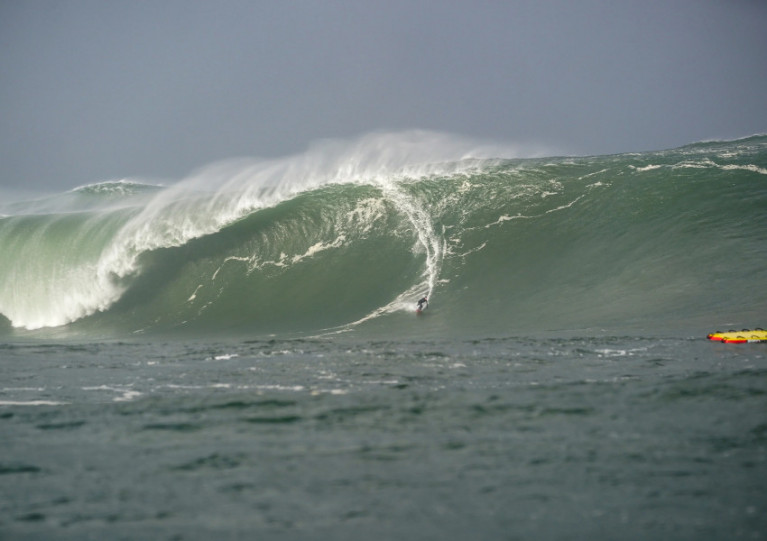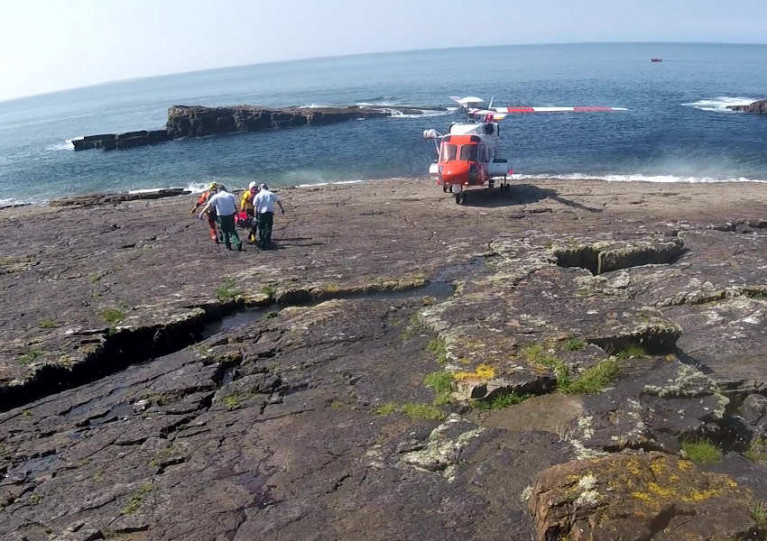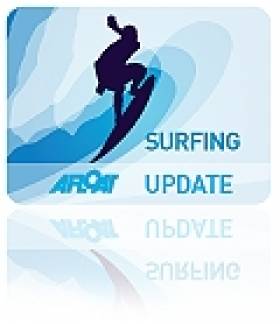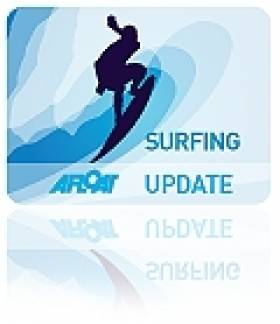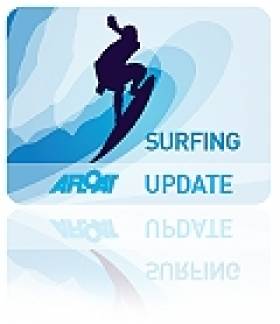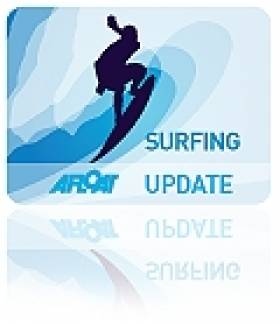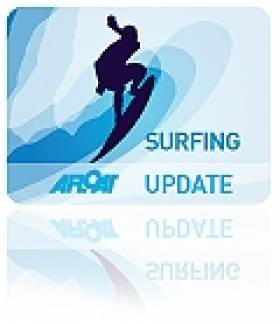Displaying items by tag: Mullaghmore Head
Big Wave Surfer Conor Maguire Takes on Mammoth Wall of Water Off Mullaghmore
Stormy weather means fuel for swelling seas off the surfing hot spot of Mullaghmore in Co Sligo.
And Irish big wave surfer Conor Maguire was there this week to catch the mammoth walls of water, as RTÉ News reports.
Three years ago, the Bundoran native made headlines for riding what’s believed to be the biggest wave ever recorded in Ireland’s waters at an estimated 60 feet.
This week he was first in line to make the most of the swell off the Sligo coast.
But for Red Bull team member Maguire, it was a mere warm-up for the bigger game at Nazaré in Portugal as the forecast shows the potential for record-breaking surf.
RTÉ News has video of Maguire’s incredible surfing feats HERE.
Conor Maguire Gets Nods in 2021 Red Bull Big Wave Awards for Surfing ‘Ireland’s Biggest Wave’
Irish surfing star Conor Maguire has been nominated for Ride of the Year in this year’s Red Bull Big Wave Awards, which recognise the most astounding big wave surfing feats the world over.
He’s also up for Biggest Tow for his breathtaking ride off Mullaghmore Head on 28 October 2020, as filmed by Clem McInerney — a 60-foot monster that’s believed to be the biggest wave ever surfed in Ireland, as previously reported on Afloat.ie.
And Conor’s also a nominee for Performer of the Year in a field with such fearless talent as Kai Lenny, who took on the fames Jaws in Hawaii; Grant Baker at the storied Mavericks break in California; and Sebastian Steudtner who took on the mammoth walls of water at Nazaré in Portugal.
A whopping $350,000 is up for grabs in the awards that “honour the athletes pushing the boundaries of what’s possible and celebrate the most death-defying surfing of the season”. The winners will be announced during the 2021 Red Bull Big Wave Awards Show on Friday 29 October.
Conor Maguire Rides ‘Ireland’s Biggest Wave’ at Mullaghmore Head
It was an opportunity too big to miss: the biggest waves ever seen at a spot already renowned for significant swells.
But big wave surfer Conor Maguire wasn’t taking any chances, making sure to consult with the proper authorities before heading out to ride what might be the biggest wave recorded at Mullaghmore Head.
As previously reported on Afloat.ie, the remnants of Hurricane Epsilon in the Atlantic brought ‘phenomenal’ class seas and waves up to 21 metres — more than double the typical height for the area — to the North West Coast earlier this week.
That would normally be a screaming alarm for surfers the world over to make the dash to Sligo, but continuing Covid-19 travel restrictions meant this time the ‘mutant’ surf was strictly for the locals.
And even at that, as the Guardian reports, veteran surfer Maguire needed to make sure he wasn’t stepping on any toes by heading out into the big blue on Wednesday 28 October.
He told surfing website Magic Seaweed: “We contacted Sligo County Council and got permission to surf, spoke to the coastguard.
“We had four skis and a paramedic on hand; two spotters on the cliff. We couldn’t have been any more safe, and [it was] the perfect time to take a good crack at it.”
Magic Seaweed has more in its exclusive interview with Conor Maguire, who also shared his story with Red Bull.
Woman Rescued After Fall From Cliff At Mullaghmore Head
A woman rescued after falling from a cliff at Mullaghmore Head yesterday afternoon (Thursday 13 August) was “very lucky that she was spotted”.
The casualty was found unconscious at the bottom of the cliff on the Co Sligo headland by concerned passers-by who alerted the Irish Coast Guard.
Bundoran’s RNLI lifeboat volunteers and the Sligo-based coastguard helicopter Rescue 118 were both called out to the scene.
And the woman was treated by helicopter and ambulance crew before being airlifted to Sligo University Hospital.
Bundoran lifeboat crew member Rory O’Connor commented: “The casualty was very lucky that she was spotted and that the alert was raised so quickly.
“We would remind anyone that if they see anyone in trouble on the coast to ring 999 or 112 and ask for the coastguard.”
'One Epic Day of Huge Surf' Caught On Film
#SURFING - A new short film tells the story of "one epic day of huge surf" at Mullaghmore Head, as Surfer Today reports.
The Northcore film 'Fathoms Left to Fall' follows some of the world's top big wave surfers as they converged on Co Sligo to take advantage of the swell, prompted by the extreme weather system known as the 'Viking storm'.
Among the Irish riders featured is 24-year-old Ollie O'Flaherty, who has been nominated for the 'biggest wave' prize in the 2012 Billabong XXL Big Wave Awards for his monster ride at Mullaghmore.
Also nominated for his outstanding effort at the Sligo surf mecca is Andrew Cotton, a Devon native who's no stranger to Ireland's big rollers.
Irish Surfer Needs Funds to Attend Big Wave Awards
#SURFING - A young surfer from Lahinch in Co Clare is in the running for the 'biggest wave' prize in the 2012 Billabong XXL contest for his monster ride at Mullaghmore Head, The Irish Times reports.
Ollie O'Flaherty, 24, is nominated along with Devon's Andrew Cotton for the massive surf they caught off Co Sligo on 8 March last.
It was the first visit to the world-class big wave spot by O'Flaherty, a science student at NUI Galway who is a veteran of the Co Clare scene.
As previously reported on Afloat.ie, it was Cotton who tackled the biggest wave on that day - a giant 50-footer - as some of the world's top surfers took advantage of the Viking swell.
Also nominated for the $50,000 (€38,280) prize is Irish-American surfer Garrett McNamara, who last year rode what is being called the biggest wave ever surfed in the world, a 90-foot goliath off Nazaré in Portugal.
According to the Irish Independent, O'Flaherty has put out a call for sponsorship so he can attend the awards ceremony next month.
"It's a massive honor to be able to represent Ireland," he said, but added that he is "pretty much on the breadline from what I'm doing".
Should he win, the Lahinch native said he intends to "put every cent back into surfing" and replace his seven broken boards.
The winners will be announced at the Billabong XXL Big Wave Awards in Anaheim, California on 4 May.
March's Big Waves Tease a Wild Summer of Surfing
#SURFING - Irish surf classifieds website Surfseekers.ie has compiled some stunning images from March's world-class surfing conditions.
From the biggest rollers in years off Mullaghmore Head in Co Sligo to the Cliffs of Moher and even as far south as Kerry, Ireland has seen some of its best surf in a long time - and things are certainly looking up for an exciting summer on the waves.
Top Surfers Tackle Biggest Rollers in Years Off Mullaghmore
#SURFING - It may have been too late for the postponed Tow-In Surf Session, but the big waves at Mullaghmore Head finally picked up this week - and some of the world's top surfers were there to take advantage of the swell.
As The Irish Times reports, an extreme weather system nicknamed the 'Viking storm' helped produced monster rollers on Thursday that are the biggest the area has seen in 15 years.
Devon surfer Andrew 'Cotty' Cotton rode the biggest wave when he tackled a 50ft giant, assisted by his Irish tow-in partner Al Mennie, while Brit boarder Tom Butler recorded the biggest barrel.
Richie Fitzgerald described the scene as "very calculated madness", noting that a safety crew was on hand as the 16-strong group took on the "huge, unruly and very dangerous swell".
The Irish Times has much more on the story, while Surfer Today has more video of the last winter swell at Mullaghmore Head HERE.
No Tow-In Surf Session for 2012
#SURFING - The second Billabong Tow-In Surf Session will not sadly run this year, following the end of the four-month waiting period yesterday.
Organisers decided to postpone the invitation-only event till next winter after conditions off Mullaghmore Head in Co Sligo failed to reach the minimum height requirement, as Magicseaweed reports.
“We’ve had a few swells that have come close,” said contest organiser Paul O’Kane of the Irish Surf Rescue Club. “However we set the standard incredibly high with the first event and were determined to only hold the event if the conditions were as good as that, if not better.”
Magicseaweed’s Ben Freeston concurred, saying that “the conditions needed for Mullaghmore to show it’s real face are so specific you might only see them a handful of times in the best years.
“This year we have had four or five swells that were big enough to be interesting, but not quite competition standard.”
The inaugural session was organised in an effort to dispel the myth that tow-in surfing, where surfers are towed by jetski to bigger offshore waves, is an irresponsible activity.
Last year's contest was also immortalised in an upcoming documentary from Mully Productions.
Top German Surfer Tries Ireland's Waves for Size
#SURFING - One of Germany's top surfers was in Ireland last week to sample some of Ireland's biggest waves, InsideIreland.ie reports.
Sebastian Steudtner was in Sligo to films a series of online views for Tourism Ireland in Frankfurt to pique the interest of German surfers and holidaymakers.
As well as mountain biking at Knocknarea and Union Woods, Steudtner took on the monster swells at Mullaghmore Head - made popular among the world's big wave surfers by the Tow-In Surf Session that's now in its second year.
The 'teaser' videos for a larger TV and online project will be premiered next week at the Berlin International Film Festival before hitting the web later in spring.
Kristina Gauges of Tourism Ireland said: "This is a fantastic opportunity to showcase the world-class surfing and adventure product available in this part of Ireland to a niche audience in Germany."
InsideIreland.com has more on the story HERE.


























